
1. At the current pace of quantitative easing, Japan’s central bank is buying so many bonds that it now has about 24 months left before there are no more bonds left to buy.
2. The BOJ is buying close to $800 billion (USD) of bonds annually. The bank’s QE program is truly gargantuan, and Kuroda made a key speech at Jackson Hole indicating he has no intention of tapering it at all.
3. Please click here now. Gold is extremely well-supported now, by both equity fund and FOREX money managers.
4. Kuroda hinted at Jackson Hole that while he won’t taper QE, he has substantial room to increase the use of his negative rates program. He’s making another key speech next Monday, and I expect him to make it clear that as enormous as his QE program is, he’s going to lower interest rates further, and make it even more important policy than QE.
5. The US jobs report is scheduled for release this Friday at 8:30AM. When Janet Yellen hiked rates last December, a huge institutional panic out of stock markets and the dollar developed.
6. These institutions surged into gold and the yen. A big jobs report number is likely to spur Janet to unveil a second rate hike at the September 21 FOMC meeting.
7. This is probably the most important jobs report of the entire year, and Janet’s reaction to it could begin a major stock market and US dollar crash.
8. The September and October timeframe is what I call “US stock market crash season”. The worst stock market crashes have historically occurred during these months, and Friday’s jobs report has the potential to create another one.
9. Gold price enthusiasts should pay keen attention to all the upcoming speeches made by key players at both the BOJ and the Fed. Those speeches and policy decisions are likely to create important changes on the charts that gold market technicians focus on.
10. On that note, please click here now. Double-click to enlarge this daily bars gold chart. Ahead of the US jobs report, gold is likely to briefly decline to the $1310 area or a bit lower, but Kuroda’s speech on Monday is likely to bring in fresh buying. The bottom line:
11. If the jobs report shows not many new jobs were created, gold is likely to rally nicely. If the report shows lots of jobs were created, Janet is likely to hike rates and create panic buying of gold as the stock market tumbles. It’s truly win-win for the Western gold community at this point in time.
12. Indian buying has also started to pick up again, and Chinese New Year buying begins in December.
13. Please click here now. Double click to enlarge this daily bars T-bond chart. There are a few different ways to interpret this chart, but it’s beginning to look like a big double top pattern may be forming, with highs in the 175 area, and the neckline at about 168.
14. Please click here now. Double-click to enlarge this daily bars oil chart. The T-bond took a bit of a tumble after Janet’s first rate hike, but then it acted as a safe haven.
15. That’s because the oil rally from about $34 to $53 was not an inflationary concern. Janet can justify a September rate hike with a good jobs report, but if oil begins a fresh rally higher, she may find that institutional money managers begin losing confidence in her ability to keep the T-bond price elevated in the face of a rise in inflation.
16. Low rates are crushing bank profit growth in Japan, Europe, and America. An oil price surge can create a major problem for central bankers in these areas; rate hikes help bank profits, but raise the risk that governments may lose control of their enormous debt servicing costs.
17. The PBOC could announce a major yuan devaluation if Janet hikes rates in September, and that could potentially unleash the type of stock market crash that occurred in 1929. It’s clear that risks are growing in a myriad of ways, and gold is the safe haven beacon that shines brightest.
18. Also, Janet is faced with a US election, a French election, an Italian referendum, as well as the “meat and potatoes” of the Brexit.
19. At Jackson Hole, she discussed the possibility of negative interest rates and new forms of QE as tools to manage the next US economic recession. The use of these tools is more good news for gold.
20. Please click here now. Double-click to enlarge this daily bars silver chart. Solid support sits just below the current price level. Note the nice “bull hook” that is taking shape on the Stochastics oscillator, at the bottom of the chart.
21. Silver is one of the greatest assets of all time, second only to gold on the greatness scale. Price enthusiasts can be buyers in the $18.50 – $16 zone. I’m one of those enthusiasts!
22. Please click here now. Double-click to enlarge this daily bars GDX chart. This price correction is a bit different from the other corrections that have occurred in 2016.
23. That’s because of the enormous importance of Jackson Hole, the jobs report, and the upcoming Fed and BOJ meetings. There is some clear technical damage, and GDX is unlikely to make new rally highs until after the September central bank meetings.
24. The current area is a buying zone for eager gold stock investors, but where the correction low occurs will be determined by Janet & Kuroda, not by technicians looking at the GDX price chart. Note the extremely low position of my Stochastics indicator, at the bottom of the chart. It suggests that gold stocks are poised to rally strongly, and that is likely to happen right after Friday’s jobs report is released!
Stewart Thomson of Graceland Updates, Guest Contributor to MiningFeeds.com

Gold moved lower early during yesterday’s session, but came back up later on and finally gold ended the session only less than $3 lower. Can we view such a reversal as a bullish sign? Not necessarily – a reversal should be confirmed by high volume and yesterday’s session wasn’t. Consequently, one needs to look at other parts of the precious metals sector for confirmations.
The above action, however, provides bearish signals, not bullish ones. Let’s start with the USD Index chart (charts courtesy of http://stockcharts.com).
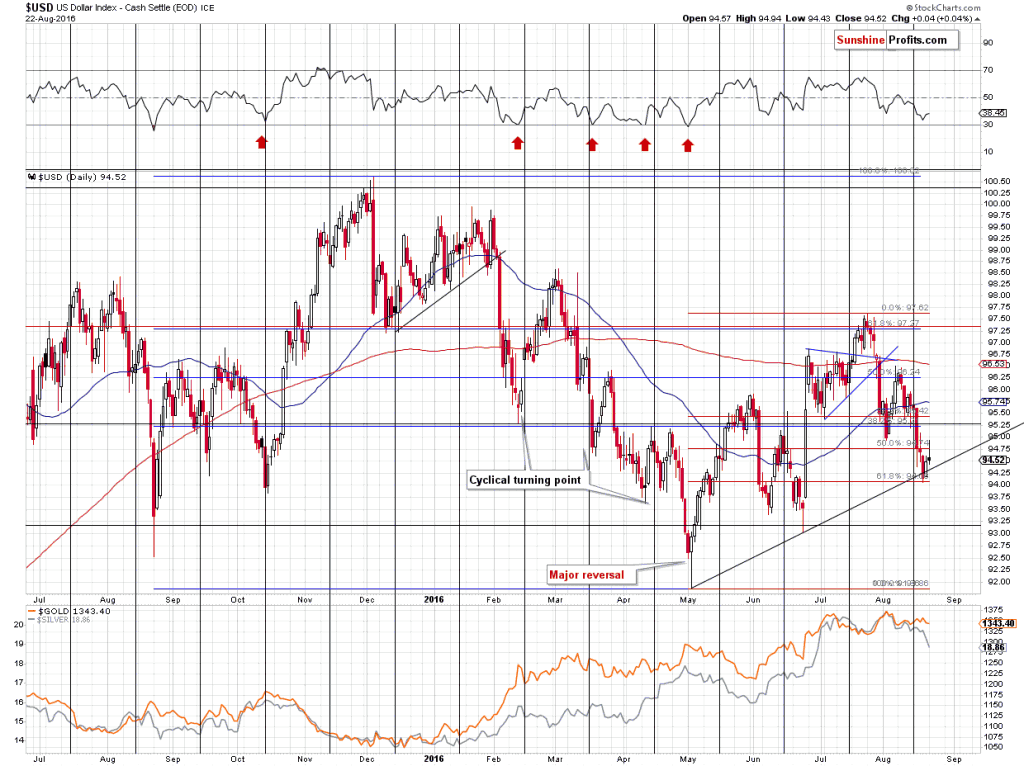
Gold had a very good reason not to decline more – the USD Index moved higher a bit and then gave the gains away. The important thing, however, is that the support line remains intact – consequently, the outlook remains bullish.
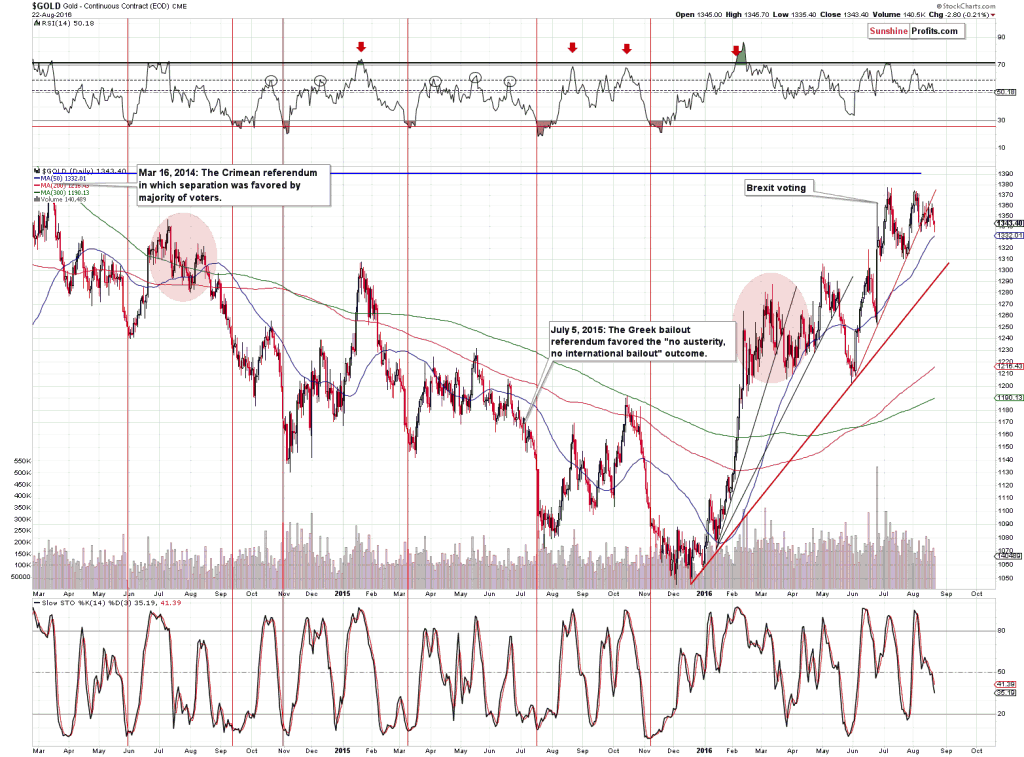
As we wrote earlier, gold reversed, but the volume that accompanied the reversal was relatively small, which suggests that it wasn’t really a “reversal”, even though the price action may suggest so.
At the first sight it may appear that technical phenomena like reversals, or breakouts etc. are just more or less random names for more or less random price movements without anything that justifies changing the outlook based on any of them. In reality, these are simple terms that refer to phenomena that are indeed happening in the market and that were found to be usually followed by some kind of action. If enough of the reliable factors are seen, the outlook may indeed change.
In case of reversals, the thing that the single candlestick on the chart represents is the situation, in which one side (bulls or bears) attempted to push the price in one direction and got almost or mostly overwhelmed by the other side. If both forces equal each other, the price will not change in terms of daily closing prices (or weekly closing prices, which was more or less the case with gold last week). Now, if the price had been falling previously and we saw this kind of action, it means that the selling pressure was no longer significant enough to trigger further declines and at the same time, the buyers were stronger than previously. The implications would be bullish. Conversely, if the price had been rallying previously and we saw the mentioned kind of action, it means that the buying pressure was no longer significant enough to trigger further upswings and at the same time, the sellers were stronger than previously. The implications would be bearish.
The key thing here is for the above to make sense, there really has to be some kind of “fierce battle” between buyers and sellers. If there was none, we couldn’t speak of one side overwhelming the other and thus about bullish or bearish implications. How can we tell, whether one side really overwhelmed the other? By looking at the volume. High volume confirms the above as it suggests that there were high numbers of both buyers and sellers who participated in that session and low volume suggests that there are little implications of this session (in terms of viewing the reversal as important).
With the above in mind, let’s take a look at yesterday’s volume. It was relatively low. Consequently, it doesn’t appear that yesterday was the session when the sellers and buyers were fighting hard to push the price of gold in a given direction with buyers fighting back strongly – significant volume would suggest the above, and instead we saw a move lower and a corrective upswing shortly thereafter. Instead of being bullish, yesterday’s session was rather inconsequential by itself.
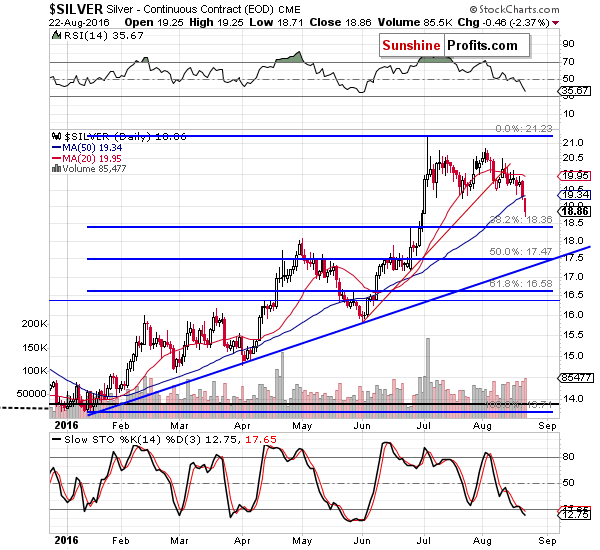
In the case of silver, however, we saw a decline on volume that we hadn’t seen in weeks. Consequently, while gold’s reversal wasn’t confirmed, silver’s decline was. The implications are bearish.
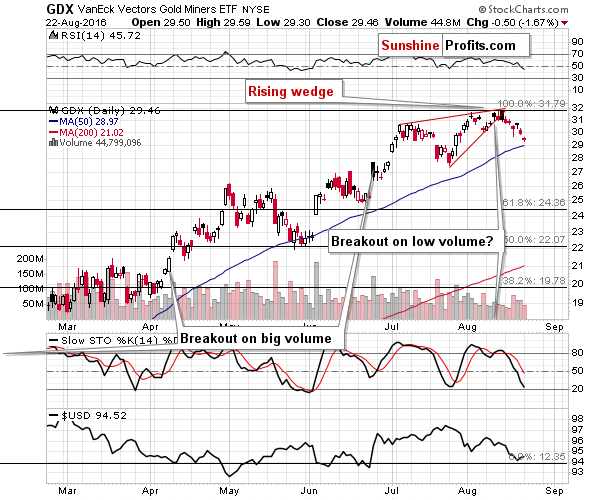
The volume wasn’t as huge in the case of mining stocks, but it wasn’t very low either and the size of the move is quite visible. Gold stocks continue to underperform gold and this is a sign that lower prices are likely to follow shortly (not necessarily today).
Summing up, the invalidation of the breakdown in the USD Index and the decline on strong volume in silver have bearish implications for the precious metals sector in the short term, while yesterday’s reversal in gold doesn’t have bullish implications.

The gold miners’ stocks have skyrocketed this year as investors started returning to this long-abandoned sector. Many have tripled, quadrupled, or even quintupled since mid-January alone! But are such epic gains fundamentally justified? Much insight into this crucial question for investors can be gleaned from the gold miners’ latest quarterly financial and operational results. Their Q2 reports just finished coming in.
Companies trading on the US stock markets are required by the Securities and Exchange Commission to file quarterly earnings reports four times a year. For normal quarters that don’t end fiscal years, these 10-Q reports are due 45 calendar days after quarter-ends. They are a great boon to financial-market transparency and investors seeking to understand companies, yielding a treasure trove of information.
The gold miners are no exception, so about 6 weeks after quarter-ends I eagerly look forward to digging into their latest quarterly reports to see how they’re faring. And the just-reported second quarter of 2016 proved an exceedingly-strong one for gold stocks. Their benchmark HUI NYSE Arca Gold BUGS Index soared 38.4% higher in Q2 on a mere 7.4% gold rally! Gold stocks’ 5.2x upside leverage to gold was extreme.
The gold stocks began 2016 at fundamentally-absurd price levels relative to gold, the overwhelmingly-dominant driver of their profits and hence ultimately stock prices. Coming out of mid-January’s crazy 13.5-year secular low, the gold stocks were certainly overdue to soar in a massive mean-reversion rally. But with the HUI skyrocketing 182.2% at best in just 6.5 months by early August, the gains have been huge!
So this once-a-quarter look we get into the gold miners’ operations and thus fundamentals is supremely important. Collectively this red-hot sector’s Q2’16 10-Qs greatly illuminate whether or not its blistering recent stock-price gains are fundamentally justified, whether or not today’s far-higher gold-stock prices are sustainable, and whether or not their powerful new bull still has legs. Investors greatly need this insight.
The definitive list of gold-mining stocks to analyze comes from the most-popular gold-stock investment vehicle, the GDX VanEck Vectors Gold Miners ETF. Its composition and performance are very similar to the benchmark HUI. GDX utterly dominates the gold-stock-ETF space, with no meaningful competition. Its net assets of $10.8b are running 33.3x those of the next-largest normal 1x-long major-gold-miners ETF!
Being included in GDX is the gold standard for gold miners, as it requires deep analysis and vetting by elite analysts. And due to ETF investing eclipsing individual-stock investing, major-ETF inclusion is one of the most-important considerations for picking great gold stocks. As the vast pools of fund capital flow into leading ETFs, these ETFs in turn buy shares in their underlying companies bidding their prices higher.
As of this week, GDX included a whopping 49 major “gold miners”! Despite being advertised as a “Gold Miners ETF” GDX also includes major silver miners, silver streamers, and gold royalty companies. GDX isn’t as pure as its name implies, but nevertheless it’s what we’ve got. This week I dug into the 10-Qs of the top 34 GDX-component companies, a number chosen because it fits neatly into the two tables below.
Collectively these 34 top GDX-component stocks account for 91.9% of its total weighting, a commanding sample. While the great majority of these companies’ Q2’16 results were released on time, a few didn’t make that 45-day cutoff. They are either foreign companies operating under inferior financial-reporting standards, or companies with June 30th fiscal year-ends. Audited annual reports have 90-day filing deadlines.
The tables below summarize some of the key data I collected from quarterly reports for these top 34 GDX components. If data wasn’t provided by a particular company, I left the relevant cells blank. The tables start with market-level information including each company’s stock symbol, exchange traded on, current weighting in GDX, market capitalization, and trailing-twelve-month price-to-earnings ratio. Blank means no P/E.
That’s followed by Q2 financial data starting with cash costs per ounce of gold mined, all-in sustaining costs per ounce, and AISC guidance for full-year 2016. Next comes quarter-end cash balances, their percentage of each company’s market cap, and Q2’16’s cash flows generated from operations. That’s followed by each company’s quarterly gold production. Silver miners’ gold-only production is listed if reported.
Collectively these 34 elite gold miners produced 9924k ounces of gold in Q2. That translates into 308.7 metric tons. According to the World Gold Council’s just-released Q2’16 Gold Demand Trends report, the definitive research on world gold supply and demand, total global mine production ran 786.9t of gold in Q2. Thus the top 34 GDX component companies account for nearly 4/10ths of the world’s total, a major chunk.
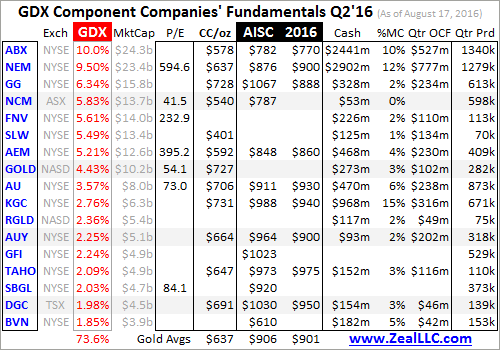
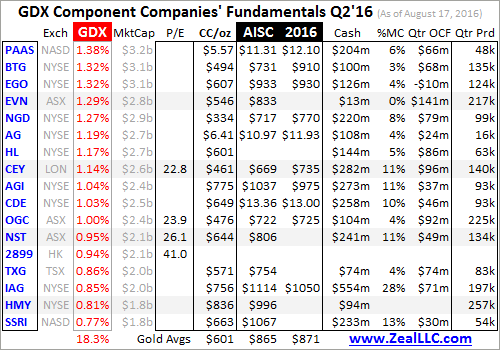
I last did this fundamental analysis of GDX’s top 34 components 3 months ago, looking at Q1’16 data. It’s really illuminating to see trends evolve quarter-on-quarter. Interestingly the big gold-stock gains in Q2 were not increasingly concentrated in these major gold miners dominating GDX’s weighting. The top 34 accounted for 96.7% of its total weight a quarter ago, but only 91.9% today. That’s likely a bullish sign.
Broadening participation, investment capital flowing into an increasing number of companies, is a key hallmark of young bull markets. The great cornucopia of bargains left in the wake of bear markets is a target-rich environment for value investors. But later as bulls mature and threaten to peak, the gains get concentrated in fewer and fewer stocks. Greedy investors chase the narrowing leaders, abandoning the rest.
GDX’s Q2’16 gain ran 38.8%, slightly besting the HUI’s 38.4%. If you add up the market capitalizations of these top 34 GDX components, they’re running $217.1b now compared to $171.5b 3 months ago. While these market caps are from about 6 weeks after quarter-ends when I do this analysis, they rose 26.6% quarter-on-quarter. Stock-price gains outpacing market-cap gains implies dilution isn’t yet a problem.
The gold miners are notorious for issuing new shares to fund mine purchases from other companies, new mine builds, and expansions of existing mines. Since mainstreamers including bankers generally don’t like gold or understand its potential, bank loans are often hard to come by. So far we haven’t seen big share issuances by the gold miners despite their sharply-higher share prices. That’s good for investors.
The gold miners’ trailing-twelve-month price-to-earnings ratios look atrocious. They are either off-the-charts high or nonexistent due to accounting losses over the last 4 quarters. With such terrible profits, how can anyone argue today’s far-higher gold-stock price levels are fundamentally justified? Investors need to understand both why the gold miners’ P/E ratios look so ugly, and why that will soon change.
Back in the 1990s before I founded Zeal, I worked as a Certified Public Accountant for an elite Big-Six firm auditing mining companies. One of the core principles we CPAs must adhere to is conservatism. That demands we anticipate possible future losses but not gains. Gold-mining assets have to be written down if lower gold prices impair their value, but are not subsequently revalued higher when gold recovers.
Back in mid-December, gold was crushed to a dismal 6.1-year secular low of $1051 right after the Fed’s first rate hike in 9.5 years. Thus gold miners suffered one of their toughest quarters ever in Q4’15. As is always the case at major bottoms, traders overwhelmingly assumed gold would keep on spiraling lower indefinitely. Gold-mining managers feared the same, and were forced to act on gold’s lower prevailing prices.
Generally-accepted accounting principles demanded they write down the carrying values of gold mines and exploration deposits on their books. The historical costs put into developing those assets were slashed to much-lower values assuming $1050 gold would persist indefinitely. The economics of gold mining are such that lower gold prices often sharply reduce the profitability and viability of extracting deposits.
So Q4’15 in particular, and to a lesser extent Q3’15 leading up to it, saw massive writedowns of gold-mining assets’ carrying values. These flowed through the income statements as losses, even though they are merely an accounting construct with no cash implications. A gold mine built for $700m written down to $500m generates $200m in accounting losses, but these are paper losses with no cash outlays at all.
Gold miners’ price-to-earnings ratios look so outrageous today because those non-cash writedowns due to extreme secular gold lows are still masking rapidly-growing operating earnings as gold recovers. The trailing-twelve-month P/E ratios extend to the past 4 quarters. So writedowns won’t roll off the books until Q4’16 in most cases, although some gold miners did their writedowns in mid-2015 instead of the end.
Once these writedowns fade into the past in the upcoming quarters, gold miners’ large and growing operating profitability will translate into big accounting earnings. That will vastly collapse industry P/E ratios, and expose the serious value inherent in gold stocks that’s now obscured. Gold stocks can’t be analyzed in conventional valuation terms until trailing-twelve-month accounting profits actually reflect operations.
Back in Q4’15, gold miners’ very survivability was called into question thanks to gold’s dire secular lows. Yet they were never at risk as evidenced by low cash costs, which are the acid test of any gold miner’s viability. They include all cash necessary to produce each ounce of gold, including all direct production costs, mine-level administration, smelting, refining, transport, regulatory, royalty, and tax expenses.
While no one is questioning gold miners’ viability in Q2’16 with gold averaging $1259 per ounce, cash costs are still important to consider. Among GDX’s top 34 companies these cash costs averaged $617 per ounce in Q2’16. That’s up 5.8% sequentially from Q1’16’s $583. But at just under half prevailing gold levels in Q2, this industry’s cash costs remain low and impressive. They rose for a couple reasons.
When gold prices are lower, mine managers often cherry pick their best ores to mine to ensure sufficient cash flows. This includes delaying digging through lower-grade ore to get to higher-grade ore below. But as gold prices mean revert higher out of last year’s extreme secular lows, that high-grading pressure abates. Mine managers can choose ore to mine more strategically, and lower-grade ores increase costs.
Mine costs and operational throughputs are essentially fixed. So if a mine is processing the same rock tonnage but recovering less gold, fixed costs are spread across fewer ounces raising cash costs. Another factor is oil prices, which rocketed 35.5% higher from Q1 to Q2 on an average basis. Diesel fuel is one of gold mining’s bigger variable costs, so higher oil prices make fueling excavators and haul trucks more expensive.
All-in sustaining costs, introduced by the World Gold Council in June 2013, are a far-superior measure of gold-mining costs and therefore operating profitability. AISC include all direct cash costs, but add on everything necessary to maintain and replenish operations at current levels. This includes exploration for new gold to mine, mine-development and construction expenses, remediation, and mine reclamation.
All-in sustaining costs also include the critical corporate-level administration to oversee the gold mines. This new metric is radically more important than classic cash costs since AISC reflect the true costs of maintaining gold mines as ongoing concerns. In Q2 these top 34 GDX components’ average AISCs weighed in at $886 per ounce. That was up 6.4% from Q1’16’s $833, essentially the same rise as cash costs.
Gold stocks are such a lucrative investment during gold bull markets because of their extreme profits leverage relative to gold. For the most part, mining costs are largely fixed during each mine’s planning stages. That’s when mining engineers decide which ore bodies to extract, how to dig them, and how to process that ore to recover the gold. These costs don’t change much regardless of what gold’s price does.
At Q2’16’s average $1259 gold price, $886 AISCs yield strong per-ounce profits of $373. That’s not only up 6.0% from Q1’16’s $352 operating profits despite higher costs, but 38.7% better than Q4’15’s $269 margins. Yet between Q4’15 and Q2’16, the average gold price only climbed 14.0%. Higher gold prices translate into much-higher profits for gold mining, making gold stocks exceedingly attractive during gold bulls.
It’s really impressive the elite gold miners were able to hold the line on all-in sustaining costs in Q2’16, despite mixing in more lower-grade ore and dealing with much-higher oil prices. As gold continues to mean revert higher on coming massive investment buying, gold-mining profitability will continue to leverage and amplify gold’s gains. That’s going to slash this industry’s P/E ratios once writedowns roll off.
The gold miners’ outlook for full-year-2016 AISCs improved slightly in Q2 as well, coming in at $888 per ounce which was slightly lower than Q1’s $890. Last year’s trial by fire helped these companies figure out how to thrive at $1050 gold, let alone Q2’s $1259 or today’s $1350 or much higher. These low costs are going to fuel much-higher operating profitability even in the current Q3, with gold averaging $1342 so far.
That suggests industry Q3’16 operating profits are running about $454 per ounce, already another 22% higher than Q2’s on a mere 6.5% quarter-on-quarter gold rally! Investors who understand gold miners’ amazing profits leverage to gold prices are the ones who’ve been aggressively buying this year and are already enjoying monster gains. By the time operations are reflected in P/Es, gold stocks will be much higher.
One key accounting number known with absolute certainty is cash on hand. If gold miners are really generating big operating profits masked by last year’s accounting writedowns, that should be evidenced in growing cash hoards. At the end of Q2, these elite top GDX gold miners had $12.0b in cash on hand. That was indeed up 13.2% sequentially from Q1’s $10.6b, definitely a strong quarterly build for this industry.
With all the short-term fictions inherent in the GAAP earnings that feed P/E ratios, a much-better read on current profitability comes from operating cash flows. They reveal current profitability or lack thereof from gold-mining operations. If gold miners are truly improving fundamentally, it must be evident in their OCFs. And their latest quarterly results proved this is indeed the case, with cash generated soaring in Q2.
Q2’16’s total operating cash flows from these elite top GDX miners weighed in at a relatively-hefty $4.1b. That’s a whopping 32.3% better than Q1’16’s $3.1b, on that mere 6.3% increase in the average gold price! Even with gold’s $1259 across Q2, the gold miners are already generating major cash flows hand over fist from mining and selling their gold. Imagine how Q3’s OCF will look with gold averaging $1342 so far.
And it’s certainly not like $1350 gold is the end of this young new bull. Investors today remain radically underinvested in gold just as lofty overvalued central-bank-goosed stock markets are overdue to roll over into major new bears worldwide. Gold is one of very few assets that generally moves counter to the stock markets, making it the ideal portfolio diversifier. Investors are going to flood back in as stock markets turn south.
All that buying will push gold prices much higher, as I explained in depth last week. Back in 2012 right before the Fed’s unprecedented open-ended third quantitative-easing campaign started levitating and grossly distorting stock markets, gold averaged $1669. Much-higher gold prices are going to lead to far-higher gold-mining profitability, as gold-mining costs are largely fixed. That means far-higher gold-stock prices!
Gold miners’ latest quarterly results just released for Q2 proved they are not only fundamentally strong today, but rapidly strengthening. This industry that was left for dead in late 2015 is going to see the best operating-profits growth by far in all the stock markets in 2016, helping to justify the epic gains in gold-stock prices already seen this year. They are rooted in big real operating-profits growth, not ethereal sentiment.
As gold-stock prices continue to rise in coming quarters, driven by soaring profits fueled by higher gold prices, great gains are still to be won. It won’t be benchmarks like GDX and the HUI that see the largest gains though, but the best individual gold miners’ stocks with superior fundamentals. These gains will be reaped by prudent investors who do their homework, rather than settling for GDX’s sector-average performance.
At Zeal we’ve spent literally tens of thousands of hours researching individual gold stocks and markets, so we can better decide what to trade and when. This has resulted in 833 stock trades recommended in real-time for our newsletter subscribers since 2001. Their average annualized realized gains including all losers are running way up at +17.6%! And that’s excluding the huge unrealized gains on our books today.
They’re running as high as 575% this week, with many doubles, triples, and quadruples this year alone! We’re also starting a major new gold-stock and silver-stock deployment to ride the coming upleg. You can read about our new trades and market timing in our acclaimed weekly and monthly newsletters. They draw on our vast experience, knowledge, wisdom, and ongoing research to explain what’s going on in the markets, why, and how to trade them with specific stocks. Subscribe today! For just $10 an issue, you can learn to think, trade, and thrive like a contrarian.
The bottom line is the major gold miners just reported an outstanding Q2’16. Despite being masked by writedown-distorted P/E ratios, these companies are enjoying major surges in operating profitability driven by the higher prevailing gold prices. That trend has persisted strongly into Q3, so fundamentals for the gold-mining industry are continuing to improve dramatically. That’s why investors are flooding back in.
Gold stocks are ready to surge again as investment demand drives gold prices higher. The gold miners’ inherent profits leverage really amplifies gold’s gains, and higher earnings entice in more investors leading to higher stock prices. Gold stocks’ young new bull is just getting started, with the biggest gains yet to come. The smart investors will be fully deployed long before P/E ratios reflect this industry’s turnaround.

1. The US dollar is coming under severe pressure against the Japanese yen this morning. That’s good news for gold.
2. To view what is essentially a financial train wreck, please click here now. Double-click to enlarge this daily chart of the dollar versus the yen.
3. The dollar is falling towards its Brexit event low in the 99 area, and that has gold poised to stage a nice upside breakout.
4. Please click here now. Double-click to enlarge this daily gold chart. Gold has essentially traded sideways against the dollar since the Brexit event in a symmetrical triangle pattern. That triangle can serve as an upside Launchpad that pushes gold to $1392, and higher!
5. I realize that many gold investors are somewhat shocked that gold has not had a serious sell-off in 2016, but that’s because the dollar has not been able to mount a serious rally against the yen.
6. Please click here now. Double-click to enlarge this daily silver chart. Like gold, silver looks strong against the dollar, and is consolidating in a rectangular price pattern.
7. An upside breakout for both gold and silver looks imminent. It may not occur until Janet Yellen makes her speech in Jackson Hole later this month, but if the dollar collapses further against the yen, the breakout is likely to happen very quickly!
8. Please click here now. Double-click to enlarge this GDX daily chart.
9. Gold stocks are in a fabulous uptrend channel. Note the inverse H&S bull continuation pattern now in play. A fresh rally towards $37 looks like it will be the next significant price movement for GDX.
10. There is not much retail participation in Western stock markets, or in gold stocks. I believe that’s because most investors have suffered through what is really a 15 to 20 year rolling super crisis.
11. Many citizens are working from paycheck to paycheck, and have multiple part-time jobs. They don’t have much capital for investing. This is a different situation from past markets where analysts used the arrival of the public to signal a “top phase” for a market.
12. Now, the average Western citizen can’t invest money in the market even if they feel greedy. The capital simply doesn’t exist. Markets are dominated by institutional money managers, pension funds, central banks, and governments.
13. For gold to have a major sell-off against the dollar, a fundamental catalyst is required that will cause institutional money managers to lighten up on their holdings.
14 Please click here now. Double-click to enlarge this important gold versus T-bonds quarterly bars chart. A rise in real interest rates can cause money managers to book profits in the gold market.
15. Note the 8.70 area on that chart. Next, please click here now. Double-click to enlarge this GDX monthly bars chart.
16. There is significant correlation between the 8.70 resistance area on the gold-bond chart and the $37 – $38 resistance area on the GDX chart. That is likely where institutional money managers will book some profits on their gold stock positions.
17. For now, the upside fun appears to be alive and well, and institutions are strong buyers of most minor sell-offs. I think amateur gold investors need to have a similar mindset.
18. Please click here now. Double-click to enlarge this daily oil chart.
19. Between now and the end of the year there are a number of events that could stop any significant sell-off in gold against the dollar from happening. A major oil market rally is one of them, and I’m predicting it happens.
20. Oil is also the largest component of most commodity indexes. Janet Yellen watches oil carefully, and she has predicted that low oil prices are temporary. Amateur investors should not bet against her. It’s hard to know how Janet would respond to a major oil price rally that raised the inflation rate significantly, but I’ll suggest that whatever she did, it would be good news for gold. Here’s why:
21. If she hiked rates, that could cause the fragile US stock market to crash, as it did when she hiked in December of 2015. The dollar crashed against the safe haven yen and gold then, and I would expect the same thing to happen again.
22. If Janet lets oil run higher without raising rates, money managers could go on a gold stock buying rampage, and the US stock market is likely to gyrate sideways in stagflationary mode, as it did in the 1970s.
23. Please click here now. Next, please click here now. There’s been a subtle but substantial rise in the slope of M2 money supply growth recently, and a stunning jump in bank credit in July.
24. Bank loan profits, money velocity, and gold stocks versus gold have all been in multi-decade bear cycles, but the winds of inflation are beginning to blow, and gold stocks are the biggest canary in the inflationary coal mine!
Stewart Thomson of Graceland Updates, Guest Contributor to MiningFeeds.com

1. Gold price bulls and bears may all be getting a bit frustrated now, as gold refuses to follow their predicted paths, and simply meanders sideways.
2. Please click here now. Double-click to enlarge this daily gold chart.
3. Gold is well-supported in the current price zone. Institutions are buyers on minor dips, but the next major move to the upside is unlikely to happen without a significant fundamental catalyst.
4. Janet Yellen makes an important speech at Jackson Hole later this month. For decades, I’ve viewed the August 7th – October 31st time period as US stock market “crash season”. If Janet causes the stock market to stumble with stronger words about a possible rate hike in September, that could quickly send gold towards my $1432 target.
5. The US election, French election, and an Italian referendum are also potential price drivers. The current global macro situation is a good one for gold price enthusiasts, but in terms of time a bit of patience is required.
6. Please click here now. Goldman’s view of what Donald Trump brings to the table (more government spending) may not sit well with members of his fan club, but the entitlements funding nightmare is something that neither US candidate seems to want to address with any degree of seriousness.
7. It’s impossible to significantly reduce government spending’s horrifying drag on the US economy without facing that entitlements nightmare directly, and taking the brutal action needed to cut the fat.
8. So, I’ve categorically stated that the election of Hillary Clinton is good news for gold, and the election of Donald Trump is great news for gold.
9. In France, ongoing terrorist attacks have destroyed Hollande’s chances of getting elected again, and the opposition nomination takes place in November. Hollande is one of the most prolific spenders in the Western world, and whoever takes over his position takes over what is really an economic disaster zone.
10. Together with the US election, the French nomination process should incentivize more money managers to buy more gold.
11. Please click here now. I’ve argued that QE was deflationary, and it would be replaced with government stimulus spending, perpetual bonds, and gold revaluation.
12. That’s a process that will take some time, but clearly some top mainstream economists are beginning to take the same viewpoint.
13. In the big picture, the world is not moving from risk-off to risk-on, but the main theme is transitioning from system risk to inflation risk.
14. On that note, please click here now. Double-click to enlarge this key gold stocks versus gold bullion quarterly bars chart.
15. Even after the “barn burner” rally during the first half of 2016, the XAU index is barely above its 2008 lows! Clearly, this a massive accumulation zone.
16. Of course there will be drawdowns for accumulators. Investors need to bring a good measure of intestinal fortitude to the table to handle those drawdowns.
17. Regardless, gold stocks are down about 80% against bullion right now, compared to the highs set about twenty years ago. Those highs were made when money velocity and bank loan profits peaked, and system risk became the dominant theme.
18. As the transition into a government stimulated inflationary bull era for gold takes place now, good times for gold stock investors will be here for a very long time.
19. I realize that a lot of investors and analysts have referred to the 2014 – 2015 time period as a “gold stocks bear market”. In contrast, I think the use of bull and bear labels can actually be a bit of a destructive force for the wealth builder. In the real world, emotions play a big role in investor action, and compulsive use of a bear market label can create irrational fear in a key accumulation zone.
20. In regards to gold stocks specifically, I called the 2014 – 2015 period the greatest accumulation zone for any asset in the history of markets. That was a bold statement, and the price action in 2016 is already hinting that my view may be the correct one.
21. Please click here now. Double-click to enlarge. This quarterly bars chart of the XAU gold stocks index versus silver bullion adds even more weight to the idea that even at current prices, gold stocks are not in a momentum buying area, but a value buying area.
22. Silver is very responsive to inflationary pressures, and if gold stocks are outperforming silver in a massive way, it’s an indication that inflation may be poised to rise in a much bigger way than most analysts believe is possible.
23. Please click here now. Double-click to enlarge this hourly bars chart for oil. There’s a great inverse H&S bottom in play, with a target price range of $45 -$46. As the largest component of most commodity indexes, an oil price rally can create substantial inflationary concerns amongst institutional investors, particularly at this late stage of the business cycle. That’s great news for gold stock enthusiasts!
24. Please click here now. Double-click to enlarge this superb GDX daily chart. A new inverse H&S bull continuation pattern has appeared, and after a brief pullback needed to form the right shoulder low, GDX should be ready to make a beeline to my $33 and $37 target prices!
Stewart Thomson of Graceland Updates, Guest Contributor to MiningFeeds.com

The gold miners’ stocks have already enjoyed a phenomenal year, blasting higher with gold’s new bull market. This sector’s market-dominating performance has been amazing. Yet incredibly, the gold stocks are only now entering their strongest time of the year seasonally. Historically during bull-market years the gold stocks have enjoyed massive autumn rallies on average, starting right about now which is very bullish.
Gold-stock performance is highly seasonal, which certainly sounds odd. The gold miners produce and sell their metal at relatively-constant rates year-round, so the temporal journey through calendar months should be irrelevant. Based on these miners’ revenues, there’s no reason investors should favor them more at certain times of the year than others. Yet history proves that’s exactly what happens in this sector.
Seasonality is the tendency for prices to exhibit recurring patterns at certain times during the calendar year. While seasonality doesn’t drive price action, it quantifies annually-repeating behavior driven by sentiment, technicals, and fundamentals. We humans are creatures of habit and herd, which naturally colors our trading decisions. The calendar year’s passage affects the timing and intensity of buying and selling.
Gold stocks exhibit strong seasonality because their price action mirrors that of their dominant primary driver, gold. Gold’s seasonality isn’t driven by supply fluctuations like grown commodities experience, as its mined supply remains pretty steady all year. Instead gold’s major seasonality is demand-driven, with global investment demand varying dramatically depending on the time within the calendar year.
This gold seasonality is fueled by well-known income-cycle and cultural drivers of outsized gold demand from around the world. Starting now in late summer, Asian farmers begin to reap their harvests. As they figure out how much surplus income was generated from all their hard work during the growing season, they wisely plow some of their savings into gold. Asian harvest is followed by India’s famous wedding season.
Indians believe getting married during their autumn festivals is auspicious, increasing the likelihood of long, successful, happy, and even lucky marriages. And Indian parents outfit their brides with beautiful and intricate 22-karat gold jewelry, which they buy in vast quantities. That’s not only for adornment on their wedding days, but these dowries secures brides’ financial independence within their husbands’ families.
After that comes the Western holiday season, where gold-jewelry demand surges for Christmas gifts for wives, girlfriends, daughters, and mothers. Following year-end, Western investors figure out how much surplus income they earned after getting bonuses and paying taxes. Some of this is invested into gold just like the Asian farmers do. Then big Chinese New Year gold buying flares up heading into February.
So during its bull-market years, gold has always tended to enjoy massive autumn rallies driven by these sequential episodes of outsized demand. Naturally the gold stocks follow gold higher, amplifying its gains due to their profits leverage to the gold price. Today gold stocks are once again right at their most-bullish seasonal juncture, the transition between the usually-drifting summer doldrums and big autumn rallies.
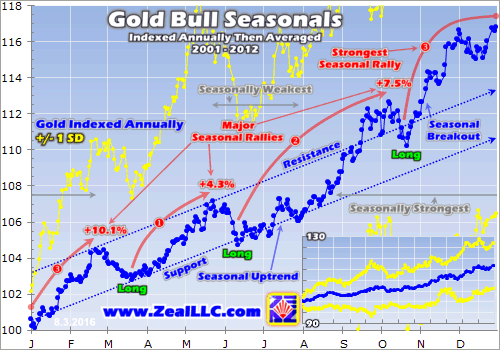
Since it’s gold’s own demand-driven seasonality that fuels the gold stocks’ seasonality, that’s the best place to start to understand what’s likely coming. Price action is very different between bull years and bear years, and gold is absolutely in a new bull market. Between the 6.1-year secular low it suffered in mid-December and early July, gold powered 29.9% higher easily exceeding that +20% new-bull threshold.
Gold’s last mighty bull market ran from April 2001 to August 2011, where it soared 638.2% higher! And while gold consolidated high in 2012, that was technically a bull year too since gold slid 18.8% at worst from its bull-market peak. Gold didn’t enter formal bear-market territory at -20% until April 2013, thanks to the near-miraculous stock-market levitation driven by extreme distortions from the Fed’s bond monetizations.
So the modern bull-year seasonality relevant to this new bull year in 2016 ran from 2001 to 2012, before the Fed-induced bear-market years between 2013 to 2015. This first chart distills down gold’s bull-year seasonal tendencies, by averaging gold prices indexed within each calendar year. This methodology is essential because it renders price percentage moves perfectly comparable despite differing prevailing gold prices.
Gold’s close on the final day of each preceding year is recast at a level of 100, with all the following year’s daily gold closes indexed off that. An indexed level of 110 simply means gold was up 10% year-to-date at that point. Each calendar year’s individually-indexed gold prices are then averaged together to arrive at this gold-bull seasonality. Gold has always had a strong tendency to enjoy major autumn rallies.
During its last bull-market years from 2001 to 2012, gold’s major autumn rally started on average in late July. While gold seasonals technically bottomed in mid-June, that was just part of gold drifting listlessly sideways in the summer doldrums between late May and late July. Gold’s major autumn rally averaging hefty 7.5% gains between mid-June and early October didn’t actually break out to the upside until early August.
And that’s exactly where we are today! Gold is on the verge of once again seeing outsized demand from those key seasonal income-cycle and cultural drivers that ignite in this late-summer period and then run well into autumn. Note above how August and September together saw gold’s strongest seasonal gains on average during its last secular bull. These next couple months are among gold’s top-performing calendar ones.
Gold averaged gains of 2.5% in Augusts and 3.3% in Septembers between 2001 to 2012, making those its 4th- and 2nd-best calendar months respectively. While Novembers take the title with 4.0% average gains, no other couple-month span outperforms August and September! Gold is just entering its strongest stretch of the year in seasonal terms, which is a very bullish near-term omen for it and gold-stock prices.
While that’s definitely exciting, this year does face some unique risk factors that could dampen gold’s usual seasonal strength. A merely average 7.5% rally from gold’s $1286 levels in mid-June would take it to $1382 by early October. But obviously gold already almost got there! 2016 saw gold blast higher during the summer doldrums in a rare counter-seasonal breakout. This proved a record summer rally for this metal.
Between the end of May and early July, gold rocketed 12.3% higher! That is radically better than bull-years’ seasonal average summer-to-date performance of -1.1% by that point. This incredible surge was driven by a combination of massive buying by both investors and gold-futures speculators. The former is great and not a problem at all, as investors are strong hands looking to own gold outright for the longer term.
But unfortunately futures speculators’ frenzied buying was the dominant force fueling gold’s radically-unprecedented summer rally. Speculators grew exceedingly bullish, ramping their upside bets on gold to towering record levels. But these hyper-leveraged gold-futures contracts are exceedingly risky, since relatively-small adverse moves in gold prices can result in total losses of the capital speculators risked.
Gold’s record summer rally this year may have borrowed from its strong autumn gains, effectively pulling some of that autumn buying forward into summer. That hinges on whether investors resume buying gold aggressively or not. And the record gold-futures longs accumulated by speculators leave gold with a near-record futures selling overhang heading into autumn. This remains a serious near-term risk for gold.
If some news or market event spooks the uber-bullish speculators, they will be forced to exit their wildly-excessive long positions en masse. This heavy gold-futures selling will drive down gold fast, forcing a snowballing number of speculators to liquidate or face catastrophic losses due to futures’ extreme leverage. So until speculators’ collective gold-futures positions normalize, a cascading gold selloff is possible any time.
I suspect gold’s strong autumn seasonals will ultimately prevail, as Asian farmers and Indian parents are not going to postpone their usual large gold buying due to extreme gold-futures positions in American markets. Nevertheless given the wildly-anomalous summer setup leading into this year’s autumn gold rally, odds are it is going to prove far more volatile than normal. Caution is in order this year, not complacency.
Gold’s strong autumn seasonals are why gold stocks enjoy strong autumn seasonals of their own. Gold stocks amplify gold’s price action because gold-mining profitability leverages it. This next chart uses the same bull-market seasonal methodology applied to the flagship HUI gold-stock index. The gold stocks are now entering their best couple-month span of the year seasonally, a very bullish portent for this sector.
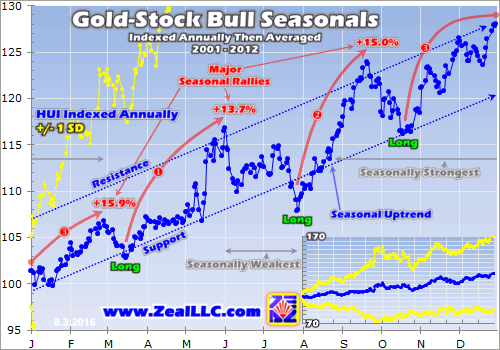
As of this week, the gold stocks as measured by the HUI have already skyrocketed 181.7% higher since their 13.5-year secular low in mid-January! That very week I pointed out the fundamental absurdity of those gold-stock prices given prevailing gold levels, and aggressively bought and recommended many new gold stocks in our newsletters. Once gold-stock bulls get underway, they grow to immense proportions.
Between November 2000 and September 2011, this leading HUI gold-stock index soared an astounding 1664.4% higher! That epic secular bull covered the vast majority of gold’s bull-market years between 2001 to 2012, so we can use those for gold-stock seasonals as well. And on average during that span of mighty bull years, the gold stocks bottomed seasonally in late July. And then massive autumn rallies erupted.
On average between late July and late September in those last modern bull years, the HUI rocketed 15.0% higher! A similar rally today from this index’s late-July low would boost the HUI to 286, and like gold we are already there in early August. Just like gold, gold stocks enjoyed a super-anomalous record summer rally this year. So they too may have seen much autumn buying pulled forward into summer.
If gold gets hit by cascading gold-futures selling as speculators are forced to rapidly unwind their still-near-record longs, gold stocks are going to fall in sympathy and amplify gold’s losses. Considering the HUI’s staggering gains, not far from a triple in just a half-year, a healthy bull-market correction wouldn’t be surprising at all. The setup leading into this year’s autumn rally is radically different than in normal years.
But while that portends much-greater coming volatility than usual just like in gold, it shouldn’t negate gold stocks’ entire autumn rally. If gold climbs on balance in the coming months as it ought to with all that outsized Asian gold demand coming online again, the gold stocks will follow it higher. Gold stocks have some aces up their sleeves as well, which could lead to investment demand really accelerating.
No other sector in all the markets is even remotely close to challenging gold stocks’ commanding performance supremacy this year. Professional investors including hedge-fund managers are really taking notice. They are having a tough time performing this year in these frustratingly-fake central-bank-levitated markets. They need to find some winners soon to salvage their years, and the momentum is in gold stocks.
Gold and gold-stock excitement is mounting after their record summers, and gold’s strong autumn seasonality is well-known. So there’s a good chance much more investment capital than usual will flood into both gold and its miners’ stocks this autumn. And these inflows will accelerate dramatically when the lofty stock markets inevitably roll over, as gold is the ultimate portfolio diversifier since it moves counter to stocks.
Thus gold’s near-record futures selling overhang and its downside threat to gold-stock prices may very well be mitigated or even negated by exceptional investment demand this autumn. It’s been years since investors got excited about gold and gold stocks, and that’s just starting to build as evidenced by all the bullish comments on the precious metals in the mainstream financial media. This autumn could prove remarkable.
Just like in their primary driver gold, gold stocks’ best couple-month span of the year seasonally comes in August and September. This next chart breaks down gold-stock bull-year seasonality per the HUI into more-granular monthly form. Each calendar month between 2001 to 2012 is individually indexed to 100 as of the previous month’s final close, and then all like calendar months’ indexes are averaged together.
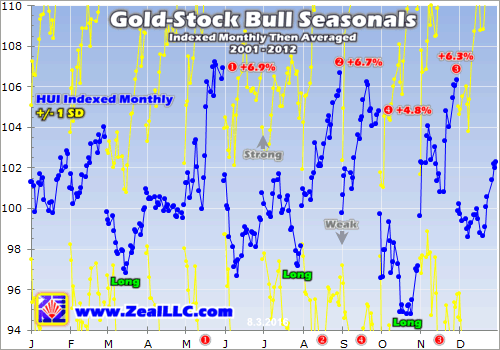
Gold stocks enjoyed big average gains in Augusts and Septembers in the bull-market years between 2001 and 2012 of 6.7% and 4.8%. These coming couple months happen to be gold stocks’ 2nd- and 4th-best months of the year! Those are the same relative rankings as gold’s monthly bull-year seasonality, but reversed. No other time of the year has a higher probability of witnessing major gains in the gold stocks.
With such massive seasonal tailwinds starting to blow, it’s hard not to be heavily long gold stocks this time of the year regardless of how far and fast they got here. With gold stocks’ epic performances this year winning growing popularity even among mainstream investors and speculators, there’s no better time for a new rush of capital to flood into them than late summer and early autumn. That’s really bullish.
But it’s important to remember that seasonals are mere tendencies, not sure things. Just like in weather, long-term averages can mask considerable extremes. This year has already seen gold stocks buck their seasonality in record ways. April is a relatively-weak month seasonally, with the HUI averaging modest 0.5% losses in bull years. Yet this past April the gold stocks greatly defied seasonality with a huge 31.0% rally!
April’s weakness is followed by May, which weighs in as gold stocks’ strongest month of the year seasonally. Its average 6.9% HUI gain between 2001 to 2012 edged out August’s 6.7%. This May the HUI plunged 13.8% as gold stocks mean reverted to give back some of April’s incredible gains! So it’s important to realize that gold stocks certainly haven’t behaved in line with seasonal norms in recent months.
This July saw the HUI surge another 11.2% higher, vastly greater than the bull-year average of a 1.9% loss. While that’s nothing like the extreme gold-stock rally seen in April, it still pressures this year’s August to diverge down from normal years’ average performance. Seasonality is important to consider, but it doesn’t actually drive anything. It just quantifies what’s caused by sentiment, technicals, and fundamentals.
While gold stocks face greater downside risk than normal in the coming weeks thanks to that extreme near-record futures selling overhang looming over gold, their sentiment, technicals, and fundamentals are still arguing for an exceptional autumn rally. Mainstream investors and speculators are getting more excited, but they aren’t yet euphoric and remain woefully under-deployed in this small contrarian sector.
Technically the gold stocks look super-bullish, with incredible strength even in the summer when there shouldn’t be much if any. And fundamentally the gold stocks remain very low relative to gold, their primary driver. This is easiest expressed through the HUI/Gold Ratio, which I last wrote about a month ago. Between 2009 to 2012, the last normal years before the Fed-spawned gold bear, the HGR averaged 0.346x.
Even this week as the gold stocks climbed to a new bull record of 283.7 on the HUI, the HGR was still only running 0.206x. Thus merely to regain post-stock-panic normal-year average levels relative to today’s prevailing gold prices in the $1350s, the HUI still has to rally another 68% higher from here! That implies a HUI trading near 470, so there are great gains still to be won in gold stocks even at these gold levels.
As always investors and speculators can play the likely coming autumn rally with the leading GDX gold-stock ETF, which closely mirrors the HUI’s performance. But a carefully-handpicked portfolio of the elite gold miners with the best fundamentals will see gains trouncing those of the benchmarks. Uncovering these winners takes incredible amounts of time, work, and expertise, but the resulting gains are well worth it.
The bottom line is gold-stock seasonals argue this sector is right on the verge of a major autumn rally. August and September are the best couple-month span of the year for gold stocks seasonally in bull-market years. This is driven by a parallel autumn gold rally fueled by outsized Asian demand coming back online. Gold stocks naturally amplify gold’s gains since their profits leverage gold’s price moves.
While this year’s autumn-rally setup isn’t as clean as usual, gold stocks still have great potential to surge in the coming months. Futures speculators drove a record summer gold rally, leaving gold with a near-record selling overhang that could cascade anytime. But mainstream excitement is growing for the red-hot gold stocks, so much bigger capital inflows are likely coming. And there’s no better time of the year to buy.

In a bull market corrections can end quickly. One minute you are projecting another 5-10% downside and the next, the market has left lower prices in the dust. A negative reaction to the Federal Reserve statement could have caused lower prices but instead Gold and gold stocks are now primed for new highs. Fundamentally, we know the Fed will do nothing to prevent real rates from remaining negative. Since the trend has turned, Gold and gold stocks have mostly ignored the moronic, empty drivel emanating from these supposed geniuses. Moreover, despite reports of increased potential for a rate hike in September, weakness in precious metals abated and buyers returned.
The hourly chart below reveals that the correction in the gold stocks was simply a retest of the July breakout from the upward sloping reverse head and shoulders pattern (in May and June). The strong rebound over the past few days allows us to deem the retest successful.
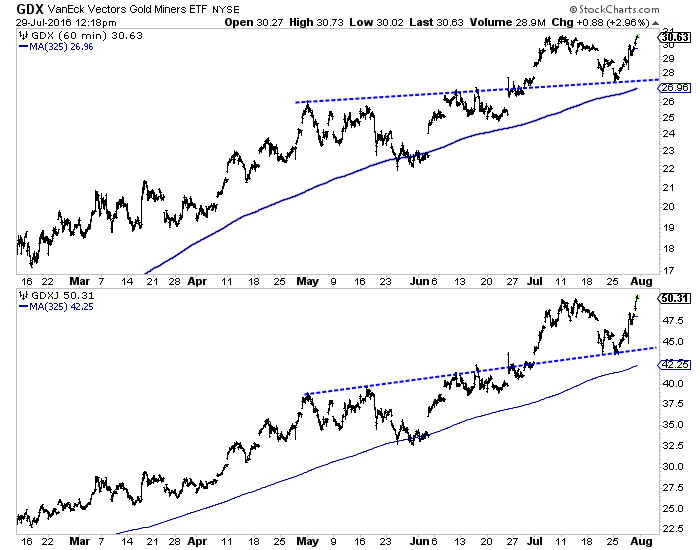
The weekly chart shows the same retest but also how the correction served as a retest of the breakout past the 2014 highs. The arrows mark the 2014 highs and the earlier low of this week. Our minimum downside targets were GDX $27 and GDXJ $41-$42. GDX touched $27 while GDXJ’s low came at $43.
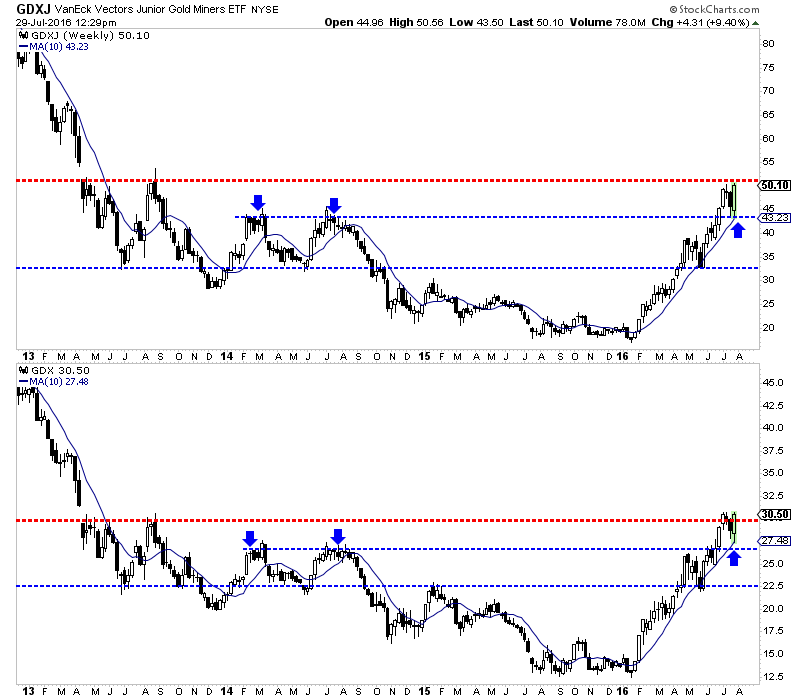
Gold has also successfully retested its breakout. We thought it could come back to a minimum of $1300 and as low as $1280. Gold bottomed at $1310 this week and is set to close the week and the month well above $1330-$1335 resistance. Moreover, the strength in the miners since Wednesday reinforces that Gold will likely follow.
Summing it up, the correction is over and Gold and gold stocks could threaten new highs in August. A few weeks of consolidation near recent highs would not be bearish though. There are just too many people on the sidelines waiting to get in this market. They have been fooled by the CoT, the US Dollar rally or the meme that miners have gained too much too fast and need a big correction. Our views are always subject to change but we continue to see Gold reaching $1500-$1550 before any counter trend move. That implies plenty more gains in the miners in the weeks and months to come. For professional guidance in riding the uptrend in Gold, consider learning more about our premium service including our favorite junior miners which we expect to outperform in the second half of 2016.
If you would like to receive our free newsletter via email, simply enter your email address below & click subscribe.
CONNECT WITH US
Tweets
Tweet with hash tag #miningfeeds or @miningfeeds and your tweets will be displayed across this site.
MOST ACTIVE MINING STOCKS
Daily Gainers
 Lincoln Minerals Limited Lincoln Minerals Limited |
LML.AX | +125.00% |
      |
GCR.AX | +33.33% |
      |
CASA.V | +30.00% |
      |
AHN.AX | +22.22% |
      |
ADD.AX | +22.22% |
      |
AZM.V | +21.98% |
      |
NSE.V | +21.05% |
      |
DYG.V | +18.42% |
      |
AAZ.V | +18.18% |
      |
GLA.AX | +17.65% |

 Follow us on Twitter
Follow us on Twitter Become our facebook fan
Become our facebook fan








